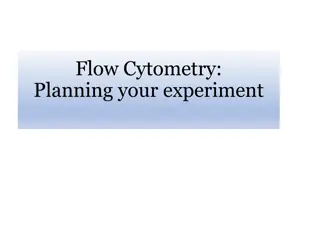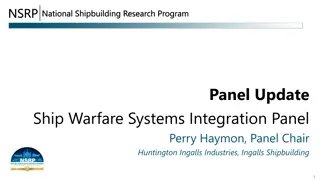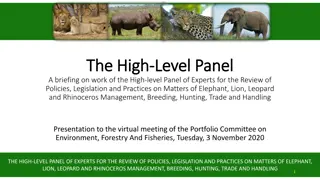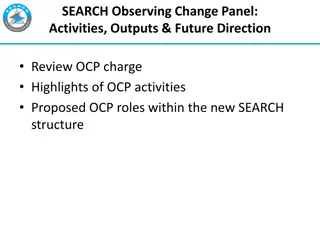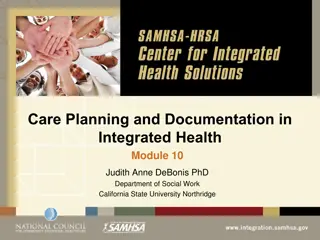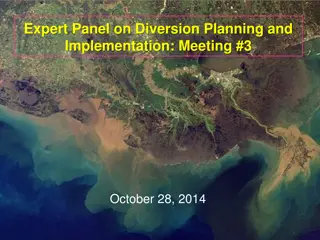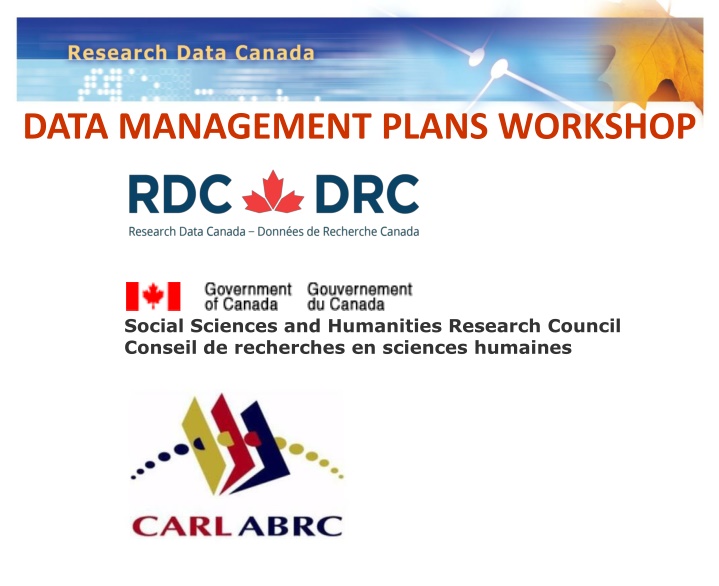
Data Management Plans Workshop in Social Sciences and Humanities Research
Explore the importance of data management plans in research excellence, highlighted by the Canadian Science Policy Conference in 2014. Learn about the evolving policies and practices, the Tri-Agency consultation, and the efforts towards establishing a culture of stewardship in Canada. Discover how data management capacity is crucial for international competitiveness and advancing digital scholarship in the country.
Download Presentation

Please find below an Image/Link to download the presentation.
The content on the website is provided AS IS for your information and personal use only. It may not be sold, licensed, or shared on other websites without obtaining consent from the author. If you encounter any issues during the download, it is possible that the publisher has removed the file from their server.
You are allowed to download the files provided on this website for personal or commercial use, subject to the condition that they are used lawfully. All files are the property of their respective owners.
The content on the website is provided AS IS for your information and personal use only. It may not be sold, licensed, or shared on other websites without obtaining consent from the author.
E N D
Presentation Transcript
DATA MANAGEMENT PLANS WORKSHOP Social Sciences and Humanities Research Council Conseil de recherches en sciences humaines
Walter Stewart, Co-ordinator Research Data Canada - Moderator Christine Trauttsmansdorff, Executive Director, Social Sciences and Humanities Research Council on behalf of Canada s Funding Agencies The TC3+ Plans for DMP Chuck Humphrey, University of Alberta Ernie Boyko, Carleton University sponsored by the Canadian Association of Research Libraries. Data Management Plans: Policy and Practice
Panel 12 Data Management Plans: Policy and Practice Canadian Science Policy Conference Halifax October 2014 2
Why data management? Why now? Excellence in data management is fundamental to research excellence Allows research results to be as freely available and accessible as possible, while ensuring that appropriate safeguards are in place. Research data management practices and policies are evolving quickly in leading research countries. Data management capacity is increasingly linked to Canada s international competitiveness. 3
Tri-Agency / CFI Consultation Fall 2013 Capitalizing on Big Data: Toward a Policy Framework for Advancing Digital Scholarship in Canada Discussed ways the agencies can promote excellence in data management practices and help to establish a Culture of Stewardship in Canada Proposed that data management plans be required as part of grant applications Highlighted the need for ongoing coordination with other players in the research ecosystem 4
Tri-Agency Approach Data management requirements will impact researchers, students and institutions, among others Long-term success depends on availability of standards, repositories, expertise and other resources. Education and awareness activities, sharing best practices, etc. are essential Coordination, consultations and communications are essential Parallel consultations on the Government of Canada Open Government / Open Science initiatives 5
GoC Open Government / Open Science Government of Canada initiative to maximize access to federally-funded scientific research, to encourage greater collaboration and engagement with the scientific community, the private sector, and the public. G8 Science Ministers Agreement: "to promote policies that increase access to the results of publicly funded research results to spur scientific discovery, enable better international collaboration and coordination of research, enhance the engagement of society and help support economic prosperity". 6
Tri-Agency: Next Steps Fall/winter 2014-15: Tri-agency working group with RDC and CAURA observers Participation in discussions such as CSPC, CASRAI, CAURA, CARL, etc. Environmental scan: K. Shearer External advisory group Promotion and awareness 2015 Public consultation on proposed policy direction Guiding principles, pilots, guidance documents, etc. Determine next steps 8
Contact Points Jeremy.Geelen@sshrc-crsh.gc.ca Philippe-Olivier.Giroux@nserc- crsng.gc.ca Jessica.Mankowski@cihr-irsc.gc.ca 9
Data Management Plans: Policy and Practice Workshop Canadian Science Policy Conference 2014 Chuck Humphrey, University of Alberta Ernie Boyko & Wendy Watkins, Carleton University
Outline Workshop objectives Context for Data Management Plans (DMPs) Why research data management Drivers and uptake DMP purpose, process, and practice Purpose: values associated with data principles Process: procedures and guidelines Practice: templates and tools An exercise
After this workshop, you should be able to: Describe to a colleague the purpose and use of a DMP, Understand the driver or drivers for DMPs that apply to your research context, Have a knowledge of the tools to produce a DMP, and Complete a draft DMP using DMP Builder.
DMP defined: form and function A data management plan is a formal statement that describes how a researcher will address specific topics on the production and stewardship of data both during and after a research project is completed. It facilitates research data management to support the research project as well as broader institutional and funder objectives. Sustain data sharing and re-use.
What is research data management? The process of controlling the research administrative information and data generated during a research project. An integral part of the research process DM is particularly challenging when studies involve several researchers and/or when studies are conducted from multiple locations. Depends on how they are produced and used throughout the research lifecycle, the types of data involved, how data are collected, stored, shared, & preserved. (Adapted from Penn State University Libraries Publishing and Curation Services: http://www.libraries.psu.edu/psul/pubcur/what_is_dm.html)
Benefits of research data management planning Helps to identify issues and strategies early in your research project. Confirms that you have documented your compliance with institutional and funder policies and ethics approval requirements. Provides focus on data sharing and re-use opportunities of your research data. Charts a pathway for your research data to remain useful and to be preserved for future use. Ensures that any questions regarding your findings can be validated using your data. (Adapted from the University of Sheffield, University Library http://www.sheffield.ac.uk/library/rdm/dmp)
Key drivers behind DMPs Data sharing Reproducible research Managing digital assets e-Science, cyberinfrastructure, and big data
Data sharing Data archives have been enabling the sharing of data for over 5 decades (e.g.,ICPSR, UKDA, Carleton) 2004 OECD Declaration on Access to Research Data from Public Funding UK Research Councils Publicly funded research data are a public good, produced in the public interest, which should be made openly available with as few restrictions as possible in a timely and responsible manner that does not harm intellectual property. US National Science Foundation [A Data Management Plan (DMP)] should describe how the proposal will conform to NSF policy on the dissemination and sharing of research results.
Reproducible Research Supports academic integrity Journals increasingly asking for data to be deposited as condition of publishing Compliance with funders expectations that research is reproducible DMPs are instruments for reproducible research
Management of digital assets Digital content (data, etc) must be managed to facilitate access and use over the long run Data stewardship acquire, manage, organize, preserve, andprovide access to massive amounts of data for use and re-use by a variety of interdisciplinary and heterogeneouscommunities over time http://besser.tsoa.nyu.edu/howard/Talks/imagem-som.pdf DMPs act as a roadmap to facilitate data stewardship
e-Science, cyberinfrastructure, and big data These have been the tectonic forces generating wider attention to the need for managing research data Jim Gray s Fourth Paradigm argument Introduction of data-intensive science Interoperating data across multiple sources to create new data E-science & big data became promoters of DMPs
Examples of DMP uptake International Polar Year DMP (2006) Genome Canada (2009) U.S. National Science Foundation (2011) Research Councils of the U.K. (RCUK) (2010- 12) U.S. Department of Energy (July 2014) International Development Research Centre
DMP purposes A DMP embodies the main elements of an organization s data policy Two examples University of Alberta Research Policy and its focus on research records stewardship Canadian High Arctic Research Station (CHARS) and its focus on access
University of Alberta Research Policy Ensure that principles of stewardship are applied to research records, protecting the integrity of the assets. [DM] plans recognize the stages through which research records will be produced, managed, documented, stored, disseminated and deposited (with either a staging or a preservation repository). Furthermore, these plans will identify the data stewards across a project s lifecycle.
DMP elements for digital assets Funder and data description Data collection Documentation and metadata Storage and backup Data sharing and re-use Preservation Responsibilities and resources (This template is taken from the University of Alberta s Data Management Plan Builder, https://dmp.library.ualberta.ca/projects/my-project-university-of-alberta-template-- 130?show_form=yes )
DMP elements for long-term access Sources for S&T data collection Data collection storage and backup Documentation and metadata Choice of data repository Terms of data deposit Terms of data access Responsibilities and resources
DMPs in practice Development of templates and tools The central themes in an organization s data policy act as the topics of a DMP template. Within these topics, relevant questions are asked about each area. A researcher then provides her or his answers to each question. Tools to help with a DMP DMPOnline (UK Digital Curation Centre) DMP Builder (Canada U of Alberta) DMP Tool (US California Digital Library) Establish a consultation process to support the use of DMPs
DMP consultation process Start a new research project Submit DMP Incorporate reviewer s suggestions in the DMP Meet with a librarian and review the DMP process Third-party review of the draft DMP Prepare an initial draft of a DMP
Exercise Prepare a DMP using DMP Builder (shortened template) around depositing data in a publication with a repository.
Hypothetical Example Hypothetical open access and data policies for the Canadian Science Policy Centre Open Access: all research publications of the CSPC will be freely available to the public through the CSPC website.
Hypothetical Example Data Policy: all data used as evidence in research publications of the CSPC will be made available to allow the findings to be reproduced. A citation for each dataset in an article or report will be included. All data will be discoverable through the use of persistent identifiers (handles or digital object identifiers) and preferably registered with DataCite Canada.
Hypothetical Example Data Policy: all data used as evidence in research publications of the CSPC will be made available to allow the findings to be reproduced. Intelligent access to data will be provided to ensure that confidentiality is protected.
Intelligent Access Intelligent access employs data management methods and services that best align user needs with the access control deemed necessary for a particular dataset. Examples of intelligent access: using visualization techniques to explore data without having to transport it, co-locating big data with high performance computing, aggregating data to guard against disclosure while safeguarding sensitive content, providing secure environments for analyzing sensitive data, and performing data linkages in a controlled setting.
Hypothetical Example 1. Will this CSPC publication involve the use of data? a. No. i. No DMP required b. Yes. i. Sources of the data 1. Data collected by the researcher 2. Data from other data providers ii. Requirement for special software or code 1. No: go to next item 2. Yes: steps to provide access to code
Hypothetical Example 2. Are there any restrictions on the data being used? a. No. i. Go to the next item. b. Yes. i. Confidentiality of research participants 1. Need for informed consent about reuse of the data ii. Data from another producer 1. Does the producer allow the data to be redisseminated?
Hypothetical Example 3. Will you deposit your data with a data repository? a. No. i. How will you make your data available? b. Yes. i. Which data repository will you use? 1. Does this repository issue persistent identifiers, such as DOIs, for research data? a. No. i. How will you obtain a persistent identifier for your data?
Hypothetical Example 3. i. Which data repository will you use? 1. Does this repository issue persistent identifiers for research data? a. No. i. How will you obtain a persistent identifier for your data b. Yes. i. Will this data repository register data DOIs with DataCite? 1. No. a. Manually enter DOI 2. Yes. a. Requirement met
Hypothetical Example 3. i. Which data repository will you use? 2. Does this repository support intelligent access? a. No. i. If 2b-i is No, exit ii. If 2b-i is Yes, how will you protect confidential information? b. Yes. i. If 2b-i is No, exit ii. If 2b-i is Yes, select an appropriate way to protect confidential information
Hypothetical Example 4. Data citation a. Has a citation format for datasets been identified?










